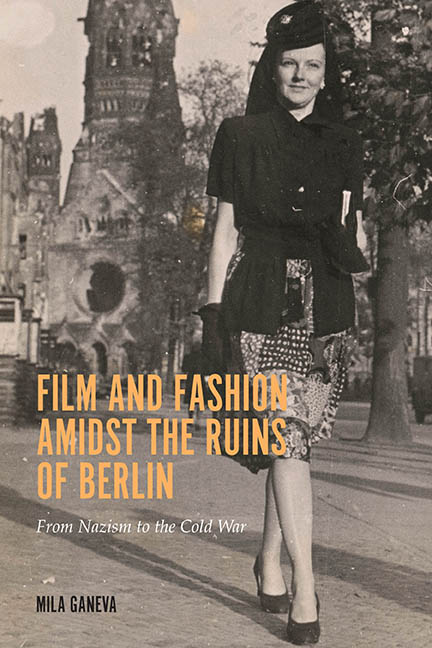Book contents
- Frontmatter
- Contents
- List of Illustrations
- Acknowledgments
- Introduction
- Chapter 1 Vicarious Consumption: Wartime Fashion in Film and the Press, 1939–44
- Chapter 2 “Fashions for Fräuleins”: The Rebirth of the Fashion Industry and Media in Berlin after 1945
- Vignette 1 Charlotte Glückstein: Historical Ruptures and Continuities in Postwar Fashion
- Chapter 3 Fashion amidst the Ruins: Revisiting Two Early Rubble Films,… und über uns der Himmel (1947) and Die Mörder sind unter uns (1946)
- Vignette 2 Hildegard Knef: Star Appeal from Fashion to Film
- Chapter 4 Farewell to the Rubble and Welcome to the New Look: Straßenbekanntschaft (1948) and Martina (1949)
- Chapter 5 Consuming Fashion on the Screens of the Early 1950s: Modell Bianka (1951), Frauenschicksale (1952), and Ingrid: Die Geschichte eines Fotomodells (1955)
- Epilogue
- Appendix 1 Principal Costume and Fashion Designers: Biographical Notes
- Appendix 2 Films and Newsreels Discussed
- Notes
- Bibliography
- Index
Vignette 2 - Hildegard Knef: Star Appeal from Fashion to Film
Published online by Cambridge University Press: 28 July 2018
- Frontmatter
- Contents
- List of Illustrations
- Acknowledgments
- Introduction
- Chapter 1 Vicarious Consumption: Wartime Fashion in Film and the Press, 1939–44
- Chapter 2 “Fashions for Fräuleins”: The Rebirth of the Fashion Industry and Media in Berlin after 1945
- Vignette 1 Charlotte Glückstein: Historical Ruptures and Continuities in Postwar Fashion
- Chapter 3 Fashion amidst the Ruins: Revisiting Two Early Rubble Films,… und über uns der Himmel (1947) and Die Mörder sind unter uns (1946)
- Vignette 2 Hildegard Knef: Star Appeal from Fashion to Film
- Chapter 4 Farewell to the Rubble and Welcome to the New Look: Straßenbekanntschaft (1948) and Martina (1949)
- Chapter 5 Consuming Fashion on the Screens of the Early 1950s: Modell Bianka (1951), Frauenschicksale (1952), and Ingrid: Die Geschichte eines Fotomodells (1955)
- Epilogue
- Appendix 1 Principal Costume and Fashion Designers: Biographical Notes
- Appendix 2 Films and Newsreels Discussed
- Notes
- Bibliography
- Index
Summary
IN LESS THAN A YEAR after her public cinematic debut in Die Mörder sind unter uns, Hildegard Knef became the brightest film attraction in the immediate postwar period, enjoying popular success and media attention like no other German actress. The film press as well as women's periodicals followed closely Knef's professional and personal moves, her work, her friendships, her varied hairstyles, and her wardrobe. In the assessment of most film scholars of the period, she quickly became the “emblem of postwar femininity,” a star whose on- and offscreen appearances merged into a single projection surface for the viewers’ desires. It has become customary to think that within the relatively short period during which Knef's star appeal was at its peak, from 1946 till the mid-to-late 1950s, her celebrity image did change, keeping pace with the dynamically changing aspirations of her female fandom. Many critical studies have examined the early trajectory of the actress's fame and tied it to the popularity of her roles as well as compelling aspects of her biography, but little attention has been paid to Knef's deep and continuous involvement with the world of fashion, with questions of style and beauty, with patterns of real and imagined consumption and lifestyle, all issues that were of vital interest to the female German public in the postwar years. Knef staged these issues visibly, in both her film roles and her offstage appearances.
This vignette offers close readings of selected scenes in three of Knef's early films against the background of her intensive mass media presence, in order to trace the interplay between film stardom and consistent fashion iconography during the late 1940s and early 1950s, an interplay that places Hildegard Knef at the center of Germany's postwar visual history. Most explorations of Knef's star image assume that she transformed from a Trümmermädchen to a femme fatale over the course of the early postwar years. I propose to show that these opposing stereotypical images were always present in Knef's stardom from the very beginning of her film career. Indeed, her association with fashion trends would continue long after she stopped filming. Thus, the designation for Knef proposed by Johannes von Moltke and Hans-J. Wulff, Trümmer-Diva, seems very appropriate, as it embraces the notion that “Knef-images refer to the symbolic practices of [her] contemporaries” (“Die Knef-Bilder verweisen auf die symbolische Praxis von Zeitgenossen”).
- Type
- Chapter
- Information
- Film and Fashion amidst the Ruins of BerlinFrom Nazism to the Cold War, pp. 105 - 120Publisher: Boydell & BrewerPrint publication year: 2018



